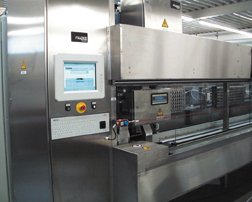Modern weighing technology, process control technology and software components can create a more productive and intelligent weighing system. All of these high-performance features are put to use in the filling system Concordia 1, even under special conditions, such as working with hazardous materials.
Angelika Laubstein
Weighing instruments and weighing systems that use today’s advanced weighing technology can play a major role in an efficient production process. In a system that combines computer and process control technology as well as data collection devices such as bar code scanners or decoders, complex processing routines can be performed at high speeds when the right weighing equipment is used. In many cases, the scale or balance supplies the production system with the values for the product variable mass; in other words, it operates as a sensor. The same applies when the samples weighed require special handling, for example within hazardous areas.
Even in the most specialized areas of production, an electronic weighing instrument must fulfill the following performance criteria:
• rapid processing (measured values/s)
• high accuracy and reproducibility of results
• stable measurements even under unfavorable ambient conditions and
• user-independent operation functions.
Weighing instruments in a filling facility
The above criteria also apply to weighing instruments that are integrated into a filling system. The use of gravimetric filling is widespread in the chemical industry, for example, where many products have high flow rates. For filling according to mass, the gravimetric method has the advantage that it is not complicated by factors of pressure, temperature or viscosity, in contrast to the volumetric method. The filling accuracy automatically remains consistent.
The most important requirements are met in full by advanced weighing technology, which can deliver
• rapid filling, with the actual fill values fed back into the control loop (digital measurement and output of up to 50 values/s, making the mass a quasi-analog control variable),
• high accuracy when measuring large and small amounts (electronic scales have wide ranges of measurement; for example, there are scales approved for use in hazardous areas or locations that have weighing capacities of 12 kg and readabilities of 0.1 g; these can measure ratios of 1:120000), and
( reproducibility ensured by the scale itself, but also through the built in, motorized calibration weight.
Weighing technology in use
An optimized combination of the possibilities presented by electronic weighing instruments in conjunction with „intelligent“ process control electronics can be found at the Fricke filling company, where scales have been integrated into their „Concordia 1“ automatic filling process. (Fig. 1). Fricke runs an automated facility for the production of flavorings and scents, using 600 to 700 different raw materials in formulas that have 40 to 50 different ingredients.
The filling system automatically mixes the products according to defined recipes, even when the equipment is not monitored by personnel. This is made possible by the data interface in the scale, through which scale functions can be activated or stopped. Each filling routine is recorded, together with its accuracy, making every step in the process completely traceable.
The containers for mixing the formulas are marked with bar codes that include the work order number. The system is started automatically or manually; then the scale, mounted on rails for mobility, is positioned at the conveyor facility, where the first container is taken and placed on the load plate. The bar code label is scanned and the computer decodes the information to determine the filling procedure. The scale then proceeds to the first filling position or chute according to the formula on the label. On conclusion of the first filling routine, the procedure and results are registered and the scale moves to the next chute. The fast data transmission rate, high resolution of the scale (0.001 g with a capacity of 2.2 kg) and great stability of the measured values combine to enable highly precise filling at fast speeds. This system can also be expanded to include up to 4 scales, which can operate simultaneously. The scale interface takes advantage of the stability of the RS485 protocol, to guard against distortion of the measured data that is sent to the computer controlling the filling machines.
Sartorius
Fax: ++49/551/30 85 72
Further information cpp-206
Unsere Webinar-Empfehlung
Die Websession „Wasserstoff in der Chemie – Anlagen, Komponenten, Dienstleistungen“ (hier als Webcast abrufbar) zeigt technische Lösungen auf, die die Herstellung und Handhabung von Wasserstoff in der chemischen Industrie sicher machen und wirtschaftlich gestalten.
Ob effizienter…
Teilen:











